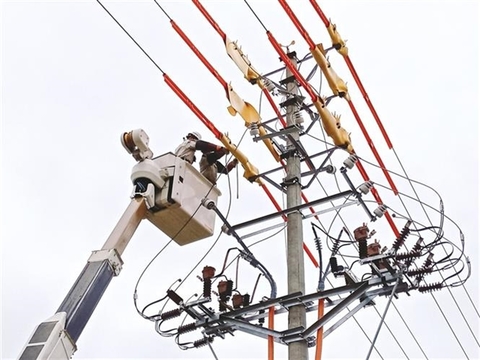
Staff of Electricity company fix the line in Bac Tu Liem District, Ha Noi. The country is predicted to face with power shortage in the future. — VNA/VNS Photo Manh Khanh
Minister of Industry and Trade Tran Tuan Anh sounded the alarm about the high risk of power shortages at a meeting earlier this week.
In a report sent to the Government and the National Assembly, Anh’s ministry said extreme weather conditions have left many hydropower plants without enough water to produce electricity.
The Ministry of Industry and Trade (MoIT) plans to import 20 million tonnes of coal in 2020 and 35 million tonnes in 2035. It also added the local supply of gas was not enough to generate electricity for projects in the southeast and the southwest of the country. There are more than 10 projects in the area accounting for 16 per cent of total capacity in Viet Nam.
MoIT said demand for liquefied natural gas (LNG) will continue to be strong, outpacing domestic production by 2020 requiring the country to import around one million cubic metres a year. Phung Van Sy, general manager of the ministry’s oil and gas division said Viet Nam’s natural gas supply is currently 9-10 billion cubic metres a year.
Currently, the electricity system still met demand for socio-economic development, however, with no backup plan, there was a risk of electricity shortage in 2020, said MoIT.
In 2021-25, even by using the maximum of oil-powered sources, there will be a shortage of electricity in the south with the shortage increasing from 3.7 billion kWh in 2021 to nearly 10 billion kWh in 2022, predicted the MoIT.
The ministry also said the highest deficit of electricity will be in 2023 with a shortage of 12 billion kWh, then a gradual decrease to 7 billion kWh in 2024 and 3.5 billion kWh in 2025.
MoIT needs to take actions to ensure national energy security, said minister Anh at the meeting.
“There are many electricity projects that are behind schedule, causing the risk of electricity shortage,” he added.
The MoIT has requested agencies review the situation and take measures to hasten the delayed projects so Viet Nam has more sources of electricity.
Together with the action, Anh told his ministry to study and find alternative solutions such as electricity imports and renewable energy. He asked them to review current mechanisms and policies of energy so see what should be changed to fix the problem.
He also asked the National Steering Committee for Electricity Development to monitor the electricity situation and to work with the State Capital Management Committee to issue capital, especially foreign currency, to help electricity enterprises in Viet am boost production.
Anh said relevant units will have a monthly working session on the matter, which they can use to review the situation of delayed projects and prepare for different power generation scenarios.
“The MoIT will have a specific report to the Government about the risk of electricity shortage and offer solutions for the problem,” said Anh.— VNS